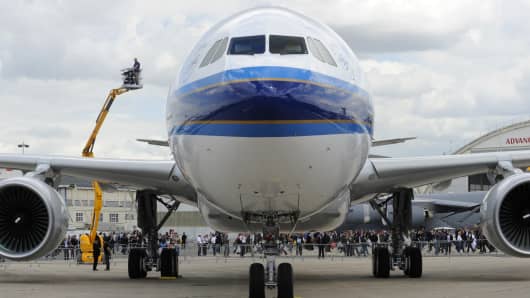Let's face it, we are on the downside of a super cycle and often enough, super cycle down phases are problematic and tumultuous at best.
Next week in Paris, the world of commercial and defense aerospace meets again at the historical Le Bourget Field at the edge of the city of light surrounded by Gallic pomp and circumstance.
Orders back to normal levels
This is a show that will have a rare level of unpredictability. It could be either an interesting or mediocre show; those looking for exceptional numbers are likely to be disappointed. Orders there will be, but it is unlikely to be the superlative numbers that Paris 2011 and Farnborough 2010 had to offer. The order books are full; now it's all about building aircraft.
Only Embraer or ATR might surprise us with significant orders, the new Embraer G2 (second-generation regional jets) might very well be the highlight of the show. The global economy is still not on solid footing and debt level surges might further dampen recovery and create dangerous variables, for the US economic recovery in particular, later this decade.
Airbus versus Boeing
Execution and financing are of paramount importance. Despite the battery hiccup, the 787 is back in the air, earlier than many had suggested at the peak of the crisis, demonstrating that Boeing can do crisis management well and deliver the goods.
Airbus will be all about the A350 aircraft and will likely be able to execute one or two flybys to the delight of the local crowd. The A350 is shaping up to be a remarkable adversary for Boeing, with a foot in both the 787 and 777 markets, and economics to more than rival both Boeing products.
(Read More: Airbus Sets First Flight of New A350 for Friday)
The elephant in the room will obviously be the 777X (a stretched and more fuel-efficient version of the 777) which is expected to be announced at the Dubai Air Show later this year. Ray Conner's first year at the helm of the Boeing Commercial Airplanes (BCA) has been impressive. He not only tackled a major event with 787, he focused sales efforts while completing much needed reorganization within the BCA leadership and averted an engineer strike. Conner has demonstrated a quiet confidence that bodes well for the future.
Fabrice Brégier's first year at Airbus has been equally strong, but in his case managing success will be his key challenge. He has inherited a massive order book from Tom Enders and, much like Ray Conner, will have to manage the production surge while adding a new US production line in Mobile, Alabama, and possibly another one. Brégier will also need to develop a counter to 777X, against which there appears to be no easy remedy.
Commercial UAS: Will the United States Lead from Behind?
It is with Unmanned Aerial Systems (UAS), often incorrectly referred to in media as "drones", that we must look for significant activity this year.
For commercial UAS in the USA, 2015 will be a bellwether year. The U.S. Federal Aviation Administration (FAA) has been working under a Sept. 2015 mandate to open up portions of the National Airspace System (NAS) to UAS operations. Incremental and expanding commercial UAS access to the NAS must happen in order for markets to develop.
A nascent commercial UAS industry must find market niches where traditional manned platforms are unable to acquire the imagery and information in a timely manner. Fortunately there is an established market for imagery and information within the U.S.,with estimates of between $4 billion to $6 billion in purchases of commercially-obtained imagery and information from aerial and space-based sensors.
(Read More: Dealing in Drones: The Big Business of Unmanned Flight)
If, as the industry fears, commercial airspace access "slides to the right" there is a probability that U.S. firms will have to play catch-up with international providers. A simple search turns up examples from Japan to Eastern Europe to Australia and beyond of novel and interesting ways that UAVs are contributing to commerce and quality and safety of life.
Unfortunately, reasoned discussions regarding UAV access to airspace are few and far between. Rational concerns over privacy have morphed into irrational fear which often drives debate. Drawing a line between the military and commercial uses of UAVs is turning out to be a difficult public relations effort.
Currently there are many more questions than answers, and reason seems absent from much debate. Commercial UAS will happen, but its U.S. evolution is wholly dependent on the creation of airspace in which to commit commerce. One hopes that those who hold high places will see international developments touted in Paris as motivation to codify and commence.
Michel Merluzeau is managing partner & Ron Stearns is research director at G2 Solutions Aerospace & Defense


